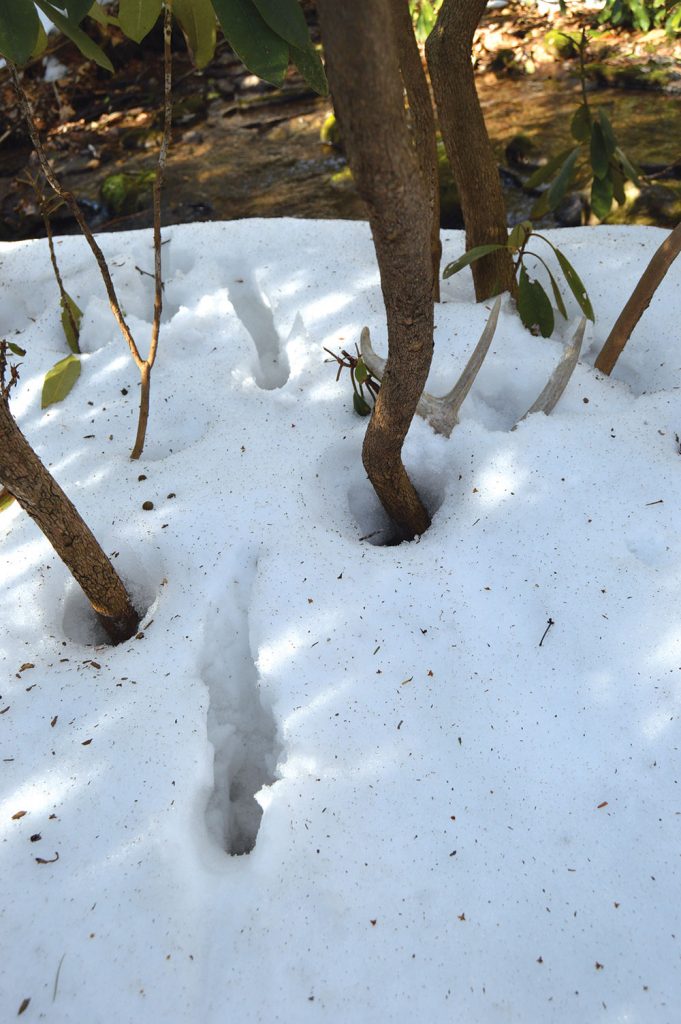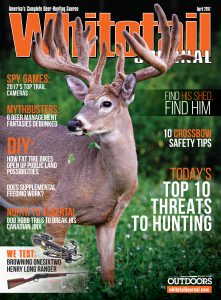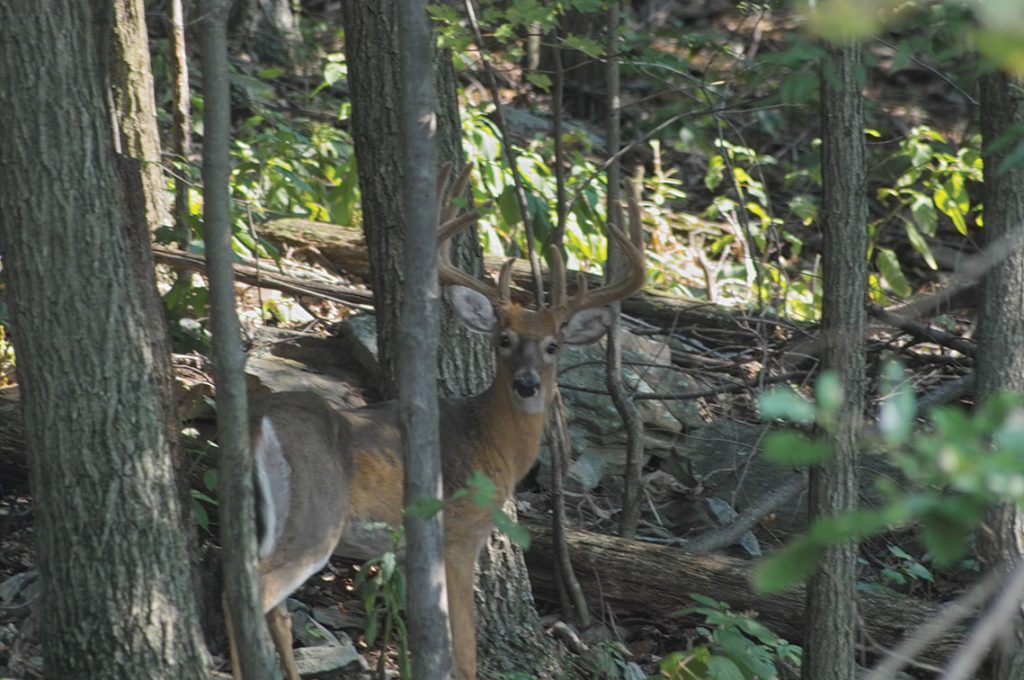Each year an undefinable thing makes a buck grow healthy new antlers from the pedicles on his head. Some say if we could find out what spurs that growth, we’d have the cure for cancer.
What’s the purpose for antlers? The consensus is that they are primarily for fighting and display. Studies have shown that, like us, female deer favor bucks with big racks.
If you’ve ever been fortunate enough to wrap your hands around the antlers of a book-class buck, you probably weren’t thinking about any of that. We're fascinated by antlers because big antlers will be connected to the head of an older, wiser buck. Taking such a buck is a milestone and/or reaffirmation of a hunter as skilled, persistent and choosy.
For some people, wrapping a hand around a shed antler is just as big of an accomplishment. These people — and you’ll know them instantly if you go to their houses, where empty large appliance cartons are filled with sheds — live for shed hunting like the majority of us live to hunt the rut.
Those crazy shed hunters? It’s a safe bet most of them have killed big bucks. While learning where to find sheds, they also learned where to find bucks.
The Biology Of Sheds
For the average U.S. buck, antler growth begins in late April or early May. Bucks enjoying the best nutrition start the earliest. Technically, antler growth begins in a male fawn when it is four months old and begins to form the pedicle.
The antler grows from the tip as a core of developing bone and cartilage, covered in velvet. To find the necessary calcium and minerals to support that growth, bucks are leaching bone density from their rib cages during this time. In late July, as testosterone levels begin to rise, the antler begins to harden. The bucks eventually rub off the velvet by scraping their racks against shrubs, and often will eat the blood-rich velvet. Why they do this is not entirely known.
What are the triggers for the growth? Biologists and scientists have been researching that for decades. We know antlers start to regrow in response to photoperiod, or increasing day length, and gradually increasing testosterone levels.
At the end of the roughly seven-month cycle, another undefinable thing happens. Testosterone level decreases and a thin layer of tissue between the pedicle and antler deteriorates. Once that happens the antler will drop off within 24 hours. Bucks only drop one antler at a time; the second one might drop off within minutes or as long as a week later. Testosterone levels drops faster in bucks living with poor nutrition.
On average, throughout the country, bucks will drop antlers beginning in mid-December, but there are lots of variables. If the buck-to-doe ratio is heavy with does and a bunch of them are running around unbred after the first main peak rut, the bucks will continue in breeding mode and the testosterone levels will remain high. The timing of shedding is also tied to the amount of available nutrition and the buck’s body condition after the rut.
In penned deer where the variables are controlled, bucks will drop their antlers at approximately the same date each year. In the wild, any change such as a shift in buck-to-doe ratio could affect the timing of the shed. The antler shed occurs earliest in the northern parts of the U.S. where the peak rut is generally shorter and more intense.
Shed Hunting 101
Bucks that are 1½ years old have antlers that are about 25 percent as big as they’ll be in their prime. At 2½ the buck displays 58 percent of his possible size; at 3½ the number is 75 percent, and at 4½ it’s 90 percent.
Many hunters might have cut their teeth on smaller bucks. As they age, they may seek only mature bucks. Getting out and finding sheds is your first clue a big buck is in the vicinity and has survived hunting season.

Bucks shed one antler at a time. The other antler might shed within minutes or it could be up to a week later.
Where to look? After the excitement and tumult of the rut, bucks and does are seeking food, shelter and water to recooperate. They also want to find places where those things they need are in easy proximity, so they don’t have to expend valuable calories obtaining them.
If you live in a snowy region it’s relatively easy to find heavily used deer trails. Deer line up like elephants, walking single file along the same trails. In areas with bare ground, target any food source such as winter forage food plots, grassy fields such as CRP areas or power lines. In northern states, deer frequent areas where they can find open water.
If legal in your area, set up feeding areas with game cameras. That way you’ll have a look at the antlers bucks are carrying, and also know when the shedding begins. If you can’t feed deer, move the cameras to heavily traveled trails you can find.
In colder months, deer will seek sunny areas such as southern-facing slopes with a tree canopy open enough for rays to reach the ground. Add a few evergreen trees or brush that blocks the wind, and that’s an area that will hold deer in winter. During winter deer will spend the majority of their time bedded, to conserve energy, which is why bedding areas are prime areas for finding sheds.
If any agricultural fields or food plots are standing, you’ll find sheds in the fields and along the perimeters. While checking trails, pay special attention to areas that have features conducive to shed drops — trails traveling through thick cover or under low branches, or places where deer make a jump, such as stream or fence crossings.
You’re going to put in many miles to find sheds.
To be most effective, start your search with a topographical map and a plan. Using the map, seek southern exposure areas and look for sheltered areas, especially in the lower elevations.
A map offers two advantages. It will allow you to make an organized search of an area, and to mark areas where you find sheds. Your shed-hunting pack should include the map, a GPS (so you can mark shed spots and find your way home), bottled water, binoculars, snacks and other essentials such as dry socks and gloves.
When planning your search, think small. It’s much better to cover a small area thoroughly than to cover a lot of ground. Coach yourself to go slowly and keep your eyes down. Take time to check your back trail for another perspective. Try to remember to look for pieces of antlers — sometimes just a tip of a tine sticks up from the leafy forest floor, or from the snow.
“The more, the merrier” applies here. The necessity of doing a slow and methodical search to be effective means it’s a great activity for kids.
Don’t be discouraged and don’t be afraid to cover the same ground again. Most avid shed hunters will tell you that it sometimes takes many outings before a shed is found. It’s not easy, but remember to view it as another form of hunting.
Antlers? Now Take Advantage of That Knowledge
The most important thing you can learn about a big buck is where he feels comfortable. The next is to learn how to hunt him without making him uncomfortable.
Those shed antler areas — where shelter, food and water are most accessible — are the places where deer go to recover from the rut. They are places where deer feel secure. Often, they are the same places where deer go when they feel hunting pressure. These places have two key features: cover and security.
In a Texas study, a 5½-year-old buck was outfitted with a telemetry collar. He lived another five years, spending his time in a small area where he ate and bedded. During those five years, he was only seen by humans four times.
Because researchers can now use telemetry collars to record activity, the most recent studies have proven that while bucks might have an expansive home range they also have a core range within that range. No matter what the geography, the core range on average is 15 percent of the size of the home range.
Here’s the key part: The bucks spend 50 percent of their time in the core range, and for most of that time they are stationary, or bedded. If you’ve found a shed honeyhole, chances are you’ve found a buck’s core range area.
How to apply that knowledge
Here’s how to apply your shed-hunting knowledge to your hunting tactics. You can be technical and use a topographical map with shed locations marked using GPS, or you can make do with a hand-drawn map. Backtrack from the shed locations to the location of feeding and watering areas that will be available during hunting season.
Before you hang a stand, factor in the prevailing wind direction for hunting season. What you’ll probably realize is it’s not going to be easy hunting a wise buck. He’s already figured out how to detect danger when he moves from the core range; in fact, he chose the core range area because he can move into the wind, sniffing for danger, when he heads to food and water. An elevated stand might not be your best tactic. You may need to opt for a ground blind with a scent-suppression feature.
Since older bucks most likely have been shot at from an elevated stand at some point in their lives, just the addition of a stand near their familiar trails might alert them to the fact that humans are in the area, or even bump them from their habitual routes. Hang stands early in the year and minimize noise, disturbance to the area and scent. Early spring shed hunting is a great time to scout for stand locations and hang stands, since the amount of available cover mimics what will be around in autumn. Also consider your approach to the area. Take your time choosing the spot, considering all the options.
Find his sheds? You’re so much closer to finding him. You’ve increased the odds that the next time you see his antlers, they might be attached.








